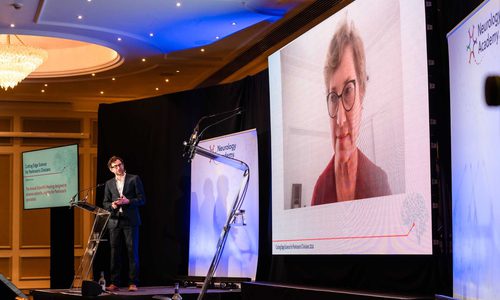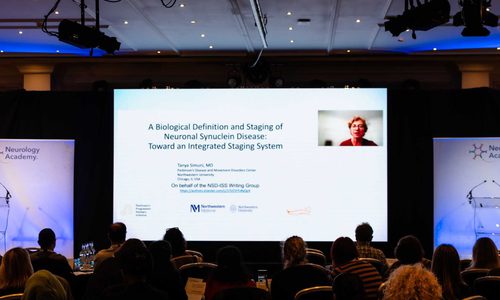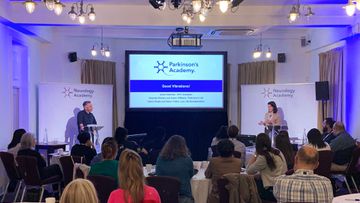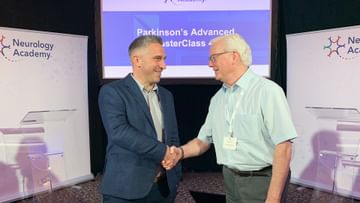Defining, staging, and the road to prevention
Event reportsOur seventh Parkinson's Cutting Edge Science conference took place on 19th March 2024 in Birmingham and was chaired by Prof Emily Henderson and Dr Neil Archibald. You can read an overview of the entire event here.
This write up is one of a series covering each session in detail for those who were unable to attend, or want to reflect on what they heard. Read more session write ups here.

The ambition of being able to predict and prevent Parkinson’s before it develops could well become a reality in the next 10 years, but first we need a biological definition of staging.
That’s according to Dr Tanya Simuni, Arthur C. Nielsen professor of neurology and division head of the Parkinson's Disease And Movement Disorders Center at the Northwestern University Feinberg School of Medicine in Chicago, USA.
“It is not futuristic to think that the current level of science advancement will allow us to transition from the concept of treating the symptoms to delaying progression, and, ultimately, preventing these diseases,” she told the Cutting Edge Science in Parkinson’s conference, held in Birmingham in March.
A biological definition of staging, she went on, is an essential landmark in this journey. Biological definition would enable the early and accurate identification of potential clinical trial participants with unified biology and co-biology, thereby increasing the chances of study success. Accurate staging makes it possible to target therapeutics and trials at earlier stages of the disease and develop stage-dependent endpoints that increase the sensitivity of the measures.
Currently, clinicians focus on managing the clinical signs of Parkinson’s and dementia with Lewy bodies (DLB), after they have become apparent. However, we know that there is a prodromal stage where the biology is present, but the manifestations are absent.
“This is the time period where we could step in and prevent disease,” said Prof Simuni. “The biology is the disease. That is not how we're thinking today in degenerative diseases, but that's where we need to transition to,” Prof Simuni
Defining neuronal α-synuclein disease1
Earlier this year, Prof Simuni’s group published A biological definition of neuronal α-synuclein disease: towards an integrated staging system for research in Lancet Neurology. In a bid to move from a clinical to a biology definition, it classes Parkinson’s and DLB, which have the shared biology of neuronal synuclein aggregation, as neuronal α-synuclein diseases (NSD). The biological definition of NSD, the paper proposes, is the presence of disease-specific neuronal α-synuclein pathology and dopaminergic neuronal degeneration.
Today, the pathology can be detected via the α-synuclein seed amplification assay (SAA). This transformational test is a highly sensitive and specific method of ascertaining the presence or absence of misfolded and aggregated synuclein, or α-synuclein, in cerebrospinal fluid (CSF). While CSF is the only validated matrix so far, work is ongoing, said Prof Simuni, to develop assays for less invasive forms of testing. The second biomarker is dopamine (DA) dysfunction, as currently measured by dopamine active transporter (DAT) imaging. “It is important to remember that any future measures of pathology or DA dysfunction may need to be incorporated into the definition,” said Prof Simuni, adding that genetics also played a role in risk.
Staging neuronal α-synuclein disease1
Providing a framework for therapeutic development across the continuum of NSD, from its earliest to its more advanced stages, is equally important. Prof Simuni explained that it would allow for the selection of patients with early biologically defined disease into clinical trials, and enable the stage-dependent selection of end-points. “This is essential for the success of therapeutic development,” she said, adding that biological staging in diseases such as Alzheimer's and Huntington’s had been “transformational”.
The NSD integrated staging system (NSD-ISS) is rooted in the biological anchors of α-synuclein pathology and DA dysfunction as well as the degree of functional impairment. It also incorporates genetic risk factors, namely the presence of pathogenic variants in the SNCA gene. It runs from stage 0 to 6, and most people diagnosed with Parkinson’s today would sit in stage 3.
A research framework
The team is not advocating for the abandonment of the terms Parkinson’s or DLB, rather that these clinical diagnoses co-exist with NSD “in a contextually appropriate way”.
“You may be asking how you diagnose someone in clinic when the majority of people do not have these biomarkers, and when they are not readily available. You would be absolutely right to ask those questions,” said Prof Simuni. The NSD biological definition, she said, was a “research framework”, and proposed the concept of “parallelism”.
That means people being considered for clinical trials of disease modification interventions, should, ideally, be screened for α-synuclein and undergo DAT imaging. Clinics, on the other hand, should continue to work with the Parkinson’s and DLB definitions “until those biomarkers become more readily available and we collect more longitudinal data”.
As our understanding increases and new biomarkers are developed and validated, she went on, NSD staging will evolve. In the future, immune and mitochondrial function, as well as lysosomal, synaptic density, and protein aggregation markers may all play a role in helping us to detect the signs of disease – and maybe even prevent it from developing.
Reference:
1. Simuni, T., Chahine, L. M., et al. (2024). A biological definition of neuronal α-synuclein disease: towards an integrated staging system for research. The Lancet Neurology, 23(2), 178-190.

This meeting is designed and delivered by the Parkinson’s Academy and sponsored by BIAL Pharma. The sponsor has had no input into the educational content of this meeting.
Related articles
'The things you can't get from the books'
Parkinson's Academy, our original and longest running Academy, houses 23 years of inspirational projects, resources, and evidence for improving outcomes for people with Parkinson's. The Academy has a truly collegiate feel and prides itself on delivering 'the things you can't get from books' - a practical learning model which inspires all Neurology Academy courses.






